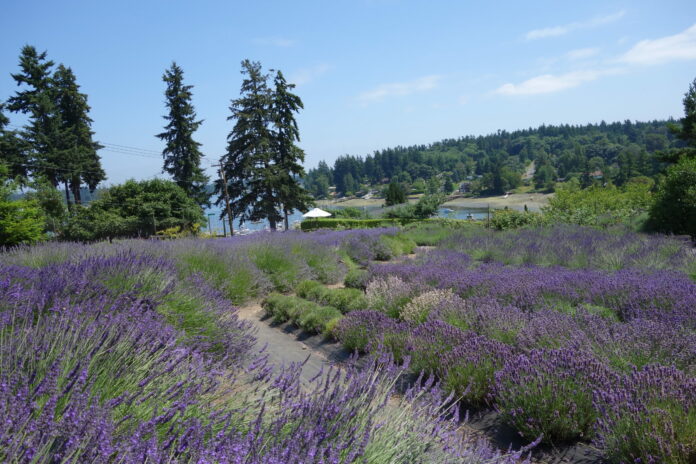Lavender, a member of the mint family, is found across Europe, the Mediterranean, north and eastern Africa, southwest Asia to southeast India and fits right into our similar environment. Everybody has their favorite type. Mine happens to be a compact English variety called Hidcote but there are hundreds available including a new, tough, variegated one called ‘Meerlo’. Here’s how to grow yours so it flourishes and doesn’t end up woody and spindly.
Lavender needs good drainage. Incorporate organic matter if necessary to make the soil loose and friable. Compost is the best amendment because it is fertile and the uneven particle sizes create better air spaces and give the roots better anchors to attach themselves to. Check the soil’s pH (potential hydrogen) to make sure it falls somewhere between 6.5 and 7.5. If the soil is too acidic the lavender will not thrive. If the soil is too alkaline, the nutrients are “tied” up in the soil and the plant cannot use them. Yellowed growth can be indicative of a soil that is out of balance. Adding compost can help to balance the pH.
Mulching with a fine mulch or compost after planting helps with the weed control. Avoid mulching right up to the stem of the small plant. Instead, leave a collar about two inches wide around the plant.
In the ground or in a pot, full sun is a must. In hot areas, some late afternoon shade can be tolerated without effecting flowering. Lavender in the field rarely needs fertilizer, especially if compost is applied as a mulch. More often, problems arise because the soil is not healthy. Avoid chemicals in pesticides, herbicides and fertilizers that kill or starve the beneficial organisms in the soil.
While Lavender is extremely drought resistant once established, they grows larger and produce more blooms with occasional deep watering depending on your soil type. This means that when the soil is dry several inches down, water thoroughly, then let it dry before soaking again. Often I see older foliage that has yellowed due to lack of moisture.
Lavender plants should be pruned every yearimmediately after bloom. Pruning should not be confused with harvesting. Pruning is necessary to extend the life of the plant. Cut back not only the flower stem, but also about a third of the gray-leaved stems as well. If the plant has been neglected, it can be cut back further, but avoid pruning back to only woody stems with no leaves showing. A plant pruned into the wood may push out latent (sleeping) buds or it may die.
It’s possible to have a lavender blooming in your garden most of the growing season. Here are my favorites.
Spanish lavenders start blooming early to mid spring. All of these do best with a good pruning about four or five weeks into the bloom cycle, which discourages these large bushes from becoming untidy and sometimes encourages a second sweep of blooms. Spanish lavender is sometimes referred to as French lavender since it grows wild in France.
French lavender has the more traditional gray leaves but with serrated edges. This large, fast growing shrub is sometimes referred to as everblooming lavender. French lavender does best when kept at no more than three feet, including blooms. Goodwin Creek lavender is a hybrid of French Lavender with a shorter growth habit and a darker purple flower head that is held on a longer wand. It makes a nice border or edging plant.
English lavenders (Lavandula angustifolias), like Munstead and Hidcote start flowering in mid to late spring. They look great when they flower, and after pruning, remain a compact ball or hedge with exotically fragrant leaves the rest of the year. Hidcote is famous for its dark purple flower.
The English hybrids come in third in the bloom cycleand continue into mid summer. These are the workhorses of the lavenders. Provence and Grosso are the best known and are the ones to line the drive or border the garden.
- Jan Nelson, a landscape designer and California certified nursery professional, will answer questions about gardening in the Santa Cruz Mountains. E-mail her at ja******@*ol.com, or visit www.jannelsonlandscapedesign.com.











